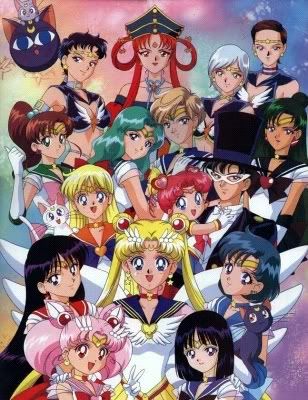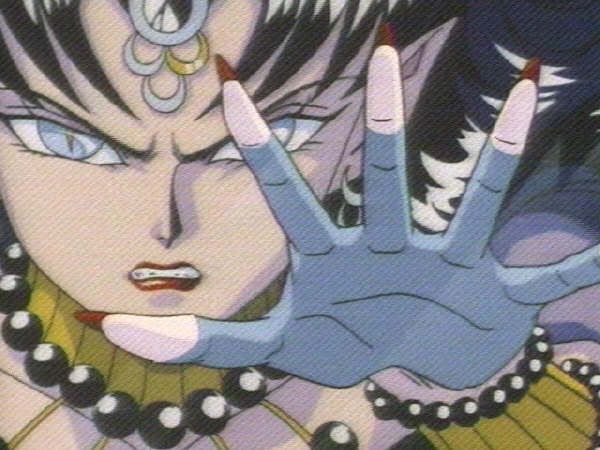Sailor Moon Finishes in Dramatic Style

Sailor Moon is the perfect depiction of the ‘magical girl’ anime subgenre. Originally airing in Japan in the early 90s, it depicted a team of schoolgirls who transformed into ‘Sailor Soldiers’ to battle evil. As anime rose in popularity in the US, Sailor Moon was at the top of the wave with its often-criticized edited English dub. Since then, the series has had five seasons, three movies, and uncensored DVD runs. While parent company Toei has since allowed the license to run out for overseas releases, the final season, Sailor Moon: Sailor Stars never saw an American release. The show has been known for its wholesome reputation and overall positive tones, but Sailor Stars finishes things off with drama, excitement, and a little darkness. Sailor Moon's past and future take place during the Silver Millennium kingdoms, the Moon Kingdom (left) and Crystal Tokyo (right).
Sailor Moon's past and future take place during the Silver Millennium kingdoms, the Moon Kingdom (left) and Crystal Tokyo (right).
Much like the initial US release of Dragonball Z, Sailor Moon received a poor reputation for the many changes made in editing and the stereotypical nature versus other anime. The typecast characters, elaborate transformations and attacks, and “monster of the day” episodes is what made it so popular but also spurned at the same time. With a rich and detailed back story that only barely gets touched upon, the Sailor Soldiers lived past lives in a monarchical society called the Silver Millennium with the Moon Kingdom as the principal ruler over the other planets and Earth. As soldiers from each planet are reborn in present-day Tokyo, the story focuses around main characters Usagi Tsukino/Serena/Sailor Moon and her destined love Mamoru Chiba/Darien/Tuxedo Mask. After discovering all of the sailor soldiers and even their future daughter Chibiusa/Rini/Sailor Chibi Moon from a second Silver Millenium in Crystal Tokyo, they fought villains that ran the gamut. While the series started stagnating after four seasons, they took things in a new direction with Sailor Stars. The previous season, Sailor Moon SuperS was criticized for heavily featuring Chibiusa in a poor storyline surrounding dreams and a unicorn named Pegasus. The main villain, Queen Nehellenia was brought back to start off Sailor Stars in a brief story arc. While the overall series has been criticized for its cute characters, personalities, and storyline, Sailor Stars brings a darker atmosphere as Queen Nehellenia attempts to overthrow the soldiers and kidnaps Mamoru. From there, status quos get overthrown and you get to see more character and plot development beyond the usual episodic story. One of the bigger changes goes to the festering relationship between Usagi and Mamoru. As a new evil approaches, Mamoru goes to study abroad in America and leaves Usagi behind. As he fails to respond to calls and letters, a new idol music group called the Three Lights comes into the scene. Front man Seiya starts to take an interest in Usagi, which leaves her emotionally torn and confused. Usually cheery or crying, you get to see more somber moments and some dramatic scenes that provide some nice variety to the “monster of the day” plots. And despite the large and growing cast of recurring characters, it never feels too crowded.
The previous season, Sailor Moon SuperS was criticized for heavily featuring Chibiusa in a poor storyline surrounding dreams and a unicorn named Pegasus. The main villain, Queen Nehellenia was brought back to start off Sailor Stars in a brief story arc. While the overall series has been criticized for its cute characters, personalities, and storyline, Sailor Stars brings a darker atmosphere as Queen Nehellenia attempts to overthrow the soldiers and kidnaps Mamoru. From there, status quos get overthrown and you get to see more character and plot development beyond the usual episodic story. One of the bigger changes goes to the festering relationship between Usagi and Mamoru. As a new evil approaches, Mamoru goes to study abroad in America and leaves Usagi behind. As he fails to respond to calls and letters, a new idol music group called the Three Lights comes into the scene. Front man Seiya starts to take an interest in Usagi, which leaves her emotionally torn and confused. Usually cheery or crying, you get to see more somber moments and some dramatic scenes that provide some nice variety to the “monster of the day” plots. And despite the large and growing cast of recurring characters, it never feels too crowded. The Sailor Starlights and their idol male counterparts.
The Sailor Starlights and their idol male counterparts.
One of the bigger reasons why Sailor Stars is largely unknown is because of its departure from previous seasons. New soldiers called the Sailor Starlights take the scene, infamous for changing from their civilian male identities as the Three Lights into female sailor soldiers. The overall atmosphere is also somewhat darker than what the series is known for. However, controversial and dark subject matter isn’t completely foreign to Sailor Moon. Third season Sailor Moon S introduces a more dramatic storyline as well as a relationship between two new female sailor soldiers, Neptune and Uranus. Despite this, Sailor Stars has a distinct feel that makes it one of the best seasons of the entire run. Not just about pretty transformations or petty school drama and stories, Stars covers more mature subject matter. Although Usagi is destined to be with Mamoru, his lack of response in America and a new love interest in Seiya leaves her with questions about obligation, destiny, and love. The action is still somewhat shallow, but the story makes up for it. The show makes some impressive improvements that bring everything to a satisfying end.
Sailor Moon: Sailor Stars is a much different show than its first season. The original showcased typical schoolgirl stories and personalities, with Usagi highlighted as a ditzy, clumsy, and crybaby hero. Sailor Stars attempts to add some true maturity and seriousness into the mix, and they succeed at times. Although it’s not revolutionary by any means, it manages to overcome the more negative criticisms that Sailor Moon has gained along the way.

